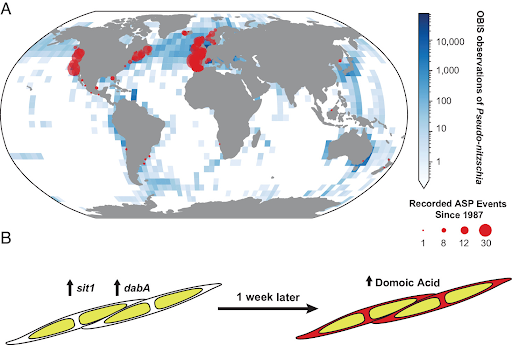A team of NCCOS-funded scientists has made a breakthrough in predicting harmful algal blooms (HABs) in the California Current Ecosystem, identifying early molecular signals that indicate when certain algae begin to produce toxins. The findings shed new light on the mechanisms that drive some Pseudo-nitzschia species to generate domoic acid (DA), a potent neurotoxin. This advancement holds critical potential for early warnings that can help safeguard public health and protect marine economies.
Toxic Pseudo-nitzschia species occur globally and are responsible for amnesic shellfish poisoning in humans which can lead to temporary or, in severe cases, permanent short-term memory loss, as well as other neurological symptoms; and DA toxicosis in marine mammals and other wildlife which can attack the brain and the heart causing seizures and heart failure. In 2015, the West Coast experienced the largest recorded Pseudo-nitzschia bloom in the Northeast Pacific, resulting in significant cultural and socioeconomic disruption that included $100 million in lost revenue to the West Coast commercial Dungeness crab and razor clam fisheries.

B. The metatranscriptomic model proposed by Brunson et al. where the expression of sit1 and dabA can predict domoic acid a week in advance of HAB impacts.
Credit: Alexander, Harriet, 2024. Molecular forecasting of toxic bloom events. PNAS.
During the 2015 HAB event, weekly water samples collected from April to September in Monterey Bay helped capture the nutrient and toxin dynamics that informed this study. Researchers used a combination of metabarcoding (which uses environmental DNA to identify which species are present) and RNA sequencing (revealing which genes are expressed and to what extent) to link active gene expression to DA production. By identifying genetic markers predictive of DA production, this research provides valuable insights for developing effective HAB monitoring, early detection, and management strategies.
The study revealed that co-expression of two genes was a reliable predictor of toxin production up to a week in advance of observed DA toxicity. Researchers also found that nutrient stress, particularly the combination of iron and silica limitation, not only constrained bloom growth but likely increased toxin output. These findings suggest that iron limitation, increasing with ocean acidification, may play a previously unrecognized role in the increasing frequency and severity of toxic Pseudo-nitzschia blooms.
This study, recently published in Proceedings of the National Academy of Sciences, was supported by the NCCOS Ecology & Oceanography of Harmful Algal Blooms (ECOHAB) project Oceanographic and Cellular Controls on Domoic Acid Production in the Central and Southern California Current System, led by the University of California San Diego, Scripps Institute of Oceanography, and the J. Craig Venter Institute. The study team included researchers from Monterey Bay Aquarium Research Institute, University of California at Berkeley, University of Southern California, University of Malaya, University of California-Santa Cruz, Moss Landing Marine Laboratories, and University of California San Diego.
ECOHAB is a peer-reviewed, national, competitive program that funds research to advance understanding of the causes and impacts of HABs and informs management of coastal resources to reduce HAB impacts and future threats.
Citation: Brunson, J. K., Thukral, M., Ryan, J. P., Anderson, C. R., Kolody, B. C., James, C. C., Chavez, F. P., Chui Pin Leaw, Rabines, A. J., Pratap Venepally, Fussy, Z., Zheng, H., Kudela, R. M., Smith, G. J., Moore, B. S., & Allen, A. E. (2024). Molecular forecasting of domoic acid during a pervasive toxic diatom bloom. Proceedings of the National Academy of Sciences, 121(40). https://doi.org/10.1073/pnas.2319177121
This work is authorized under the Harmful Algal Bloom and Hypoxia Research and Control Act (33 U.S.C. §§ 4001 et seq.), which authorizes NOAA to detect and monitor harmful algae.
